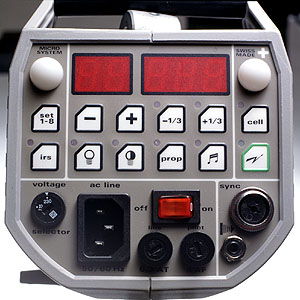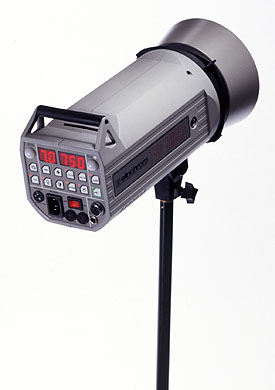
 One of the unique selling points of Elinchrom flash over the last fifteen
years has been the consistency and simplicity of its user interface.
Having got the design basically right back in the early 1980s, the Swiss
manufacturer has never needed to cycle through the endless variants of
range, series and model encountered from other makers.
One of the unique selling points of Elinchrom flash over the last fifteen
years has been the consistency and simplicity of its user interface.
Having got the design basically right back in the early 1980s, the Swiss
manufacturer has never needed to cycle through the endless variants of
range, series and model encountered from other makers.This has two important effects - first of all, it reduces cost enormously, as the design and tooling costs cover a decade rather than a couple of years, and secondly it enhances reliability as small improvements are made to internals and accessories. It also helps maintain secondhand values and user confidence.
So, when Elinca preview a monobloc flash with a brand new moulded synthetic body casing, new fittings and fixtures and a radically different electronic design the questions we ask must be:
The new Micro 750 monobloc head seems to answer all three questions positively. It costs �945 plus VAT - expensive for a mono head until you consider the features it offers. Inside the Micro 750 is a communications and control system derived from the Micro 1500 pack, and sharing the same hand remote controller.
What this means is that the Micro 750 can be added seamlessly to a Micro generator-pack based system, or that several Micro 750 heads can perform the same function as a Micro pack with multiple asymmetrical heads.
Costwise, the 750 is more expensive than an EL 1000 head and cheaper than the industrial-strength 1500 monobloc. Two Micro 750s also work out cheaper than a single Micro 1500. This sounds like aggressive pricing. In terms of reliability, the electronic output control and remote communications are both now a couple of years into production and have passed their teething phase.
Compatibility is total - the reflector bayonet is unchanged, the modelling lamp output can easily be matched to standard series heads, and the 'Micro' aspect uses the same eight-channel controller with its simple plus-minus buttons for sending the power up or down.
But how useful is a monobloc head with an LED display on its rear face, and a hand controller which can not actually mirror this display?

Then another photographer called in and had a look, and dismissed the head as next to useless. 'How do you know what power you have set, when the head is up in the air, aiming into a brolly over to one side, or behind you?', he asked. The hand controller does not display this, and unless you can see the back panel of the flash, you don't know.
However, this is not a valid criticism. You have equal difficulty seeing what power is set on a manually controlled flash head in the same conditions, and if you can't reach the head because it's on a track or a high stand, you can't adjust it.
In practice, the proprtionally modelling lights, your eyes and your flashmeter are the tools you use to set up flash. You do not need to know exactly how many tenth-stop increments any given flash head has been adjusted - it is easy enough to set any head to minimum or maximum power quickly if necessary.
 The value of the Micro hand controller is that from your flash-metering
or camera position, depending on how you work, you can adjust any head
independently and fire either selected heads or the complete set-up for
metering or Polaroids. You can turn modelling on or off, kill selected
lights entirely, test lighting ratios and toggle a few functions like
audible recycling signals.
The value of the Micro hand controller is that from your flash-metering
or camera position, depending on how you work, you can adjust any head
independently and fire either selected heads or the complete set-up for
metering or Polaroids. You can turn modelling on or off, kill selected
lights entirely, test lighting ratios and toggle a few functions like
audible recycling signals.
Combined with ceiling tracking, the Micro 750 forms the basis of a studio where the folding steps only live behind your monorail, and don't get trailed around to let you reach flash-head controls. The difference in your own freedom and 'poise' whether shooting people, or working with an art director, is considerable.
The only thing you can't do with multiple Micro 750s, but can do with three heads attached to a Micro pack, is to change the overall power of a set-up in a single operation.
However, you can set every head to operate with third-stop bracketing, automatically varying the output with sequential shots. Some photographers might choose to keep overall fill light unchanged, and auto-bracket only their accent or key lights, thus changing the contrast of the shot rather than its density.
Return to Photon September 96 contents